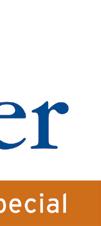






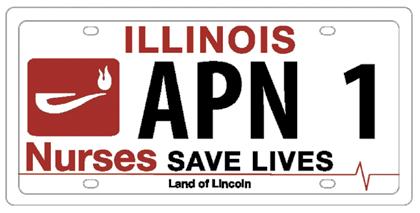
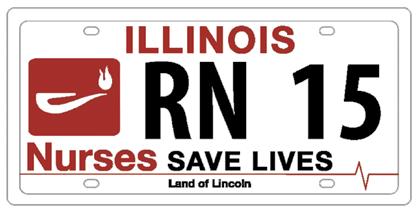
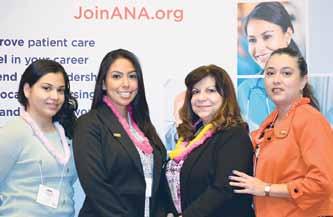
Nurses from across Illinois gathered in Bloomington, Illinois to be part of the 3rd Annual ANA-Illinois Membership Assembly. Members were joined by nursing students from around the region to participate in the Lessons in Leadership speaker series. “Lessons in Leadership” (a video series made possible through a grant from The Gordon and Betty Moore Foundation) offers a unique and flexible method of bringing student nurses, novice nurses and established leaders into a conversation about how to grow as a leader and how to position oneself as a leader in various settings. The video series is designed to stimulate meaningful dialogue; so expert nurse leaders were on-site to emphasize key concepts, lead discussion, and serve as the expert panel for the question and answer sessions.
ANA-Illinois president, Pam Brown shared with those present the association’s progress toward meeting the 2015-2018 strategic goals: (1) Promote a safe, ethical environment as well as the health and wellness of nurses in all settings; (2) Advance the quality and safety of patient care in a transforming health care environment; (3) Optimize professional nursing practice and the quality of health care in Illinois through leadership development and by ensuring full use of the knowledge and skills of RNs and APNs; and (4) Aggressively grow membership by acquiring, engaging and retaining members.
President Brown reviewed updates about the work being done at the national level, and work being spearheaded by ANA-Illinois as we continue to be a colead of the Illinois Healthcare Action Coalition. She
Assembly continued on page 4
Dear Illinois Nurse Colleagues,
INF Board of Directors

As I write this column, the Cubs are in the playoffs, Pope Francis has returned to Rome after reminding America what is important and the Miss America pageant is over. By now, I am sure you have all heard about Miss Colorado, Kelley Johnson, who delivered an inspirational monologue about her role as a nurse in the talent competition of the 2015 Miss America pageant. In contrast to the usual talents displayed in this show, Nurse Johnson chose to showcase her passion for nursing as her talent. She did this by sharing her realization through her patients that she was not “just a nurse” but a NURSE, someone who makes a difference by changing and saving lives of those receiving care.
Ms. Johnson gave voice to what we all know and feel about nursing – that it is an honor and a privilege to be a nurse – to be with another at the moment of birth or death – to be there FOR another at a crucial moment in life. To be a person with a purpose beyond one’s own needs – to be as Pope Francis calls us to be “other centered” and not self-centered. Her monologue inspired many who were watching and listening but not so much the hosts of a nationally televised talk show, the View. In response to the hosts’ negative, ignorant comments, made I am sure for comedic intent, nurses and their



supporters came out in droves to force a retraction and public backlash, including the withdrawal of some of the show’s sponsors.
Nursing and nurses showed the power of the collective! What an impressive force nursing turned out to be when united for a common cause! It demonstrates why nursing has been called the sleeping giant of health care – our collective strength goes largely untapped without unity of cause.
This is true for the Illinois Nurses Foundation as well. If all Illinois nurses united in support of the INF, we would become a major foundation – able to do much more for nurses and health care in Illinois. You have the opportunity to demonstrate our collective strength and show your passion for nursing by supporting the Foundation’s efforts to promote nursing and health care in Illinois in a couple of different ways – you can make a contribution to the Foundation, and you can reserve your nursing license plate. You can easily do this by going to the INF website, www.illinoisnurses. foundation/, where the homepage has links for making a direct donation and for reserving your nursing plate. A couple of clicks and you can help show how strong the Foundation can be!
You may think that you can’t give enough to make a difference but if every registered nurse in Illinois donated just $10, our endowment would more than triple. Please consider helping us show our passion for nursing, our collective strength, and our commitment to promoting the development of our profession and providing quality health care. Donate and reserve your nursing license plate today!
Thanks for all you do,
Esther J. Appler, 93, of Oregon, died peacefully at home on August 2, 2015. After graduating with a Masters of Nursing from Yale University in 1950, Esther began her nursing career as Assistant Director of the School of Nursing at KSB Hospital in Dixon. She went on to serve as Executive Director of the Ogle County Tuberculosis Association, Director of Nursing at Sauk Valley College, and Assistant Professor of Medical-Surgical Nursing at Northern Illinois University. She ended her career in 1988 as an Academic Advisor of Nursing at NIU. Esther was a long-standing member of the 13th District INA and advisor to the ISNA. Esther exemplified a life of service to not only her family and church, but also to her profession. An Esther J Appler Memorial Scholarship fund has been established at Northern Illinois University Department of Nursing. A Celebration of Life honoring Esther is planned in October. For more information contact
memorial@ gmail.com


Officers
Maureen Shekleton, PhD, RN, DPNAP, FAAN President
Alma Labunski, PhD, MS, RN Vice President
Cathy Neuman, MSN, RN, CNAA Secretary/Treasurer
Directors
Cheryl Anema, PhD, RN
Maria Connolly, PhD, CNE, ANEF, FCCM
P. Joan Larsen, RN
Karen Egenes, EdD, MSN, MA, RN
Linda Olson, PhD, RN, NEA-BC
Lauren Mardirosian, BSN, RN
Officers
2015-2017 ANA-Illinois Board of Directors
Dan Fraczkowski, MSN, RN President
Ann O’Sullivan, MSN, RN, CNE, NE-BC, ANEF
Sarah Gabua, DNP, RN Treasurer
Kathryn Serbin, MS, DNPc, RN Secretary
Directors
Pam Brown, PhD, RN, ANEF
Karen Egenes, EdD, MSN, MA, RN
Elaine Hardy, PhD, RN
Alyssa Hayward, BSN, RN
Bonnie Salvetti, BSN, RN
Editorial Committee
Editor Emeritus
Alma Labunski, PhD, MS, RN
Chief Editors
Lisa Anderson-Shaw, DrPH, MA, MSN
Karen Mayville, MSN, PhD, RN
Members
Cheryl Anema, PhD, RN
Margaret Kraft, PhD, RN
Linda Olson, PhD, RN, NEA-BC
Executive Director
Susan Y. Swart, MS, RN, CAE
ANA-Illinois/Illinois Nurses Foundation
Article Submission
• Subject to editing by the INF Executive Director & Editorial Committee
• Electronic submissions ONLY as an attachment (word document preferred)
• Email: info@ana-illinois.org
• Subject Line: Nursing Voice Submission: Name of the article
• Must include the name of the author and a title.
• INF reserves the right to pull or edit any article / news submission for space and availability and/or deadlines
• If requested, notification will be given to authors once the final draft of the Nursing Voice has been submitted.
• INF does not accept monetary payment for articles.
Article submissions, deadline information and all other inquiries regarding the Nursing Voice please email: info@ana-illinois.org
Article Submission Dates
(submissions by end of the business day)
January 15th
April 15th
July 15th
October 15th
Advertising: for advertising rates and information please contact Arthur L. Davis Publishing Agency, Inc., 517 Washington Street, P.O. Box 216, Cedar Falls, Iowa 50613 (800-626-4081), sales@ aldpub.com. ANA-Illinois and the Arthur L. Davis Publishing Agency, Inc. reserve the right to reject any advertisement. Responsibility for errors in advertising is limited to corrections in the next issue or refund of price of advertisement.
Acceptance of advertising does not imply endorsement or approval by the ANA-Illinois and Illinois Nurses Foundation of products advertised, the advertisers, or the claims made. Rejection of an advertisement does not imply a product offered for advertising is without merit, or that the manufacturer lacks integrity, or that this association disapproves of the product or its use. ANA-Illinois and the Arthur L. Davis Publishing Agency, Inc. shall not be held liable for any consequences resulting from purchase or use of an advertiser’s product. Articles appearing in this publication express the opinions of the authors; they do not necessarily reflect views of the staff, board, or membership of ANA-Illinois or those of the national or local associations.
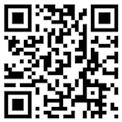

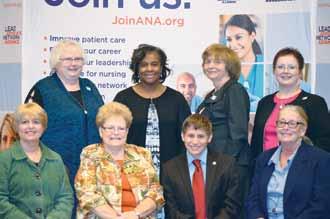
Members of the ANA-Illinois elected Dan Fraczkowski MSN, RN as president of the professional association that represents the interests of Illinois’ 170,000+ registered nurses (RNs).
The members also elected three members to the ninemember board of directors - secretary, Kathryn Serbin MS, DNP(c), RN, directors at large, Pam Brown PhD, RN and Elaine Hardy RN, PhD.
Fraczkowski works as an informatics nurse and serves as adjunct faculty at Loyola University Chicago Marcella Niehoff School of Nursing. He earned his baccalaureate and master’s degrees in nursing from Loyola University Chicago Marcella Niehoff School of Nursing and is currently pursuing a PhD from the University of Illinois at Chicago. Fraczkowski served as president of the Student Nurses’ Association of Illinois from 2006 to 2007.
Serbin serves as the associate chief nurse for surgical services at the James A. Lovell Federal Health Care Center in North Chicago. She has a master’s degree in psychiatric nursing and is currently pursuing her doctorate in nursing practice, which should be completed in 2015. Serbin is a decorated CAPT of the Navy and after 25 years of service is retiring this December.
Brown is the immediate past president of the association and has been involved in the professional association for 30 years. She is currently serving as faculty at Blessing Rieman College of Nursing in Quincy. Brown earned her PhD from Wayne State University, Master’s degree in nursing from Southern Illinois University, Edwardsville and her baccalaureate degree in nursing from Quincy College.
Hardy is the director of University of Illinois at Chicago College of Nursing in Peoria. Hardy earned her associate’s degree in nursing from Purdue University North Central, her baccalaureate degree from Indiana University Northwest, Master’s degree from Purdue University Calumet with a post-master’s certificate in nursing education. She earned her doctorate from University of Illinois at Chicago with a concentration in Women’s Health.
Those continuing their terms on the ANA-Illinois Board are: Vice President Ann O’Sullivan MSN, RN, CNE, NE-BC, ANEF; Director at Large Karen Egenes EdD, MSN, MA, RN; Director-at-Large Alyssa Grzegorzewski BSN, RN; Director-at-Large Bonnie Salvetti BSN, RN.
Elected to serve on the Nominations Committee are: Sue Carlson, DNP, RN and Karen Kelly EdD, RN, NEA-BC.

I am honored to be writing to you today as President of ANAIllinois. I would like to thank each of you who participated in the recent elections for the ANA-Illinois Board of Directors. Whether you voted, campaigned for a candidate, or went the extra mile and sought office, your commitment to the profession makes us stronger. The Nominations Committee worked diligently to prepare a robust slate of candidates. Their efforts were evident in the number of nurses seeking office in ANA-Illinois.

By the time you read this message, work will already be underway for the Nurse Practice Act Sunset, which occurs in 2017. Every ten years the nursing community comes together to review the Illinois Nurse Practice Act and make recommendations for revision if appropriate. The work begins at the grassroots level, with nurses just like you who volunteer to serve on committees or provide input at forums across the state. Your recommendations are then crafted into line by line changes in the Nurse Practice Act, in consultation with the Illinois Department of Financial and Professional Regulation. Just like any other bill in the state legislature, the Nurse Practice Act begins in one chamber of the legislature and must go through the entire process in order for it to become law.
We have formed workgroups and advisory panels of nurses across the state of Illinois to ensure that your voice is heard no matter your practice setting, specialty, or role in the profession. Similarly, we will be gearing up for the spring legislative session where ANA-Illinois will be leading the effort for Illinois to become a part of the Nurse Licensure Compact. We also expect to support nurse friendly candidates, and that will likely include a few Registered Nurses who are candidates in the 2016 election. I hope that you can join us at the variety of advocacy
events we will host, including our annual Student Nurse Political Action day in Spring 2016. Stay tuned on our Facebook Page, Twitter feed (@ANAILNurses) or website www.ana-illinois.org for more details.
As we enter 2016, I’d like our organizations to develop a shared calendar that can be an online resource of activities no matter what association is hosting the event. I want to make it easier for any nurse to be able to go to one source that we all share and publicize so that he or she can keep up to date on opportunities for advocacy, professional advancement, or philanthropy.
When I was an undergraduate nursing student at Loyola University Chicago, I had the privilege of serving as President of the Student Nurses Association of Illinois (SNAI), from 2006-2007. I developed invaluable professional skills through that experience that aren’t typically included our traditional educational preparation. If you are reading this message as a pre-licensure student and aren’t already a member of the National Student Nurses Association (NSNA) and your local SNAI chapter, I encourage you to take another look at all they have to offer. SNAI will be hosting a Leadership workshop in March of 2016 in Bloomington/Normal, Illinois. More details will be available as Spring approaches via www. snaillinois.com, or SNAI’s Facebook page, or twitter feed @SNAIllinois. ANA-Illinois is committed to support and develop future nurse leaders through our partnership with the Student Nurses Association of Illinois.
As I highlighted in my campaign video (available via my Facebook page or Twitter feed (@NurseDanF), I plan to continue to share video messages to our members and the broader Illinois nursing community. Together we will explore innovative new strategies to share all the exciting things that are happening here at ANA-Illinois and our organizational affiliates which include the Illinois Association of Colleges of Nursing, Illinois Hispanic Nurses Association, Illinois Society of Advanced Practice Nursing, and Philippine Nurses Association of Illinois. I hope you can join us on our journey together.
Dr. Luther Christman once wrote, “Those who think big, do big things. Everything is difficult when it is not done. But everything is easy when it is done in service to mankind.”


stressed how important it is to continue to engage in challenging conversations about the future of nursing practice. The members celebrated the 37.4% increase in membership, as well as our continued partnership with ANA as a control state in ANA’s Membership pilots.
Important, is our continual effort to be a unified voice for nursing, and we accomplish this by collaborating with other nursing organizations. ANA-Illinois sees its role in the nursing community as one of “convener” of like-minded individuals and associations. To this end, we continue to invite nursing associations to join ANA-Illinois as organizational affiliates and are proud to have forged solid relationships with the Illinois Hispanic Nurses Association, Philippine Nurses Association of Illinois, Illinois Association of School Nurses, Illinois Association of Colleges of Nursing, and the Illinois Society for Advanced Practice Nursing.
ANA-Illinois also serves as the lead in the Illinois Coalition of Nursing Organizations (ICNO) which serves as a “think tank” for nursing issues. ICNO members include 23 various nursing associations located in Illinois. The ICNO will be the leaders in the 2017 Sunset of the Nurse Practice Act. Watch for more information about this work in the months to come.
Attendees provided valuable feedback to the board on the threeyear work plan for the association. The perfect ending to the day was the dessert reception, hosted by the Illinois Nurses Foundation (INF). Maureen Shekleton, President of INF, took time to thank everyone for supporting the valuable work the Foundation does throughout the year.

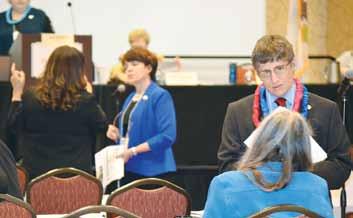
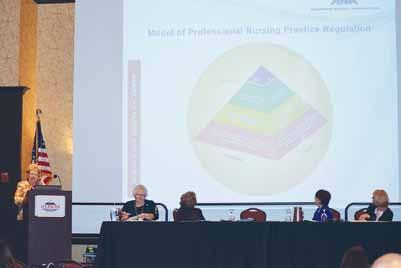

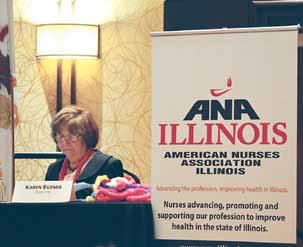
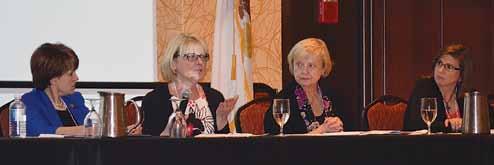
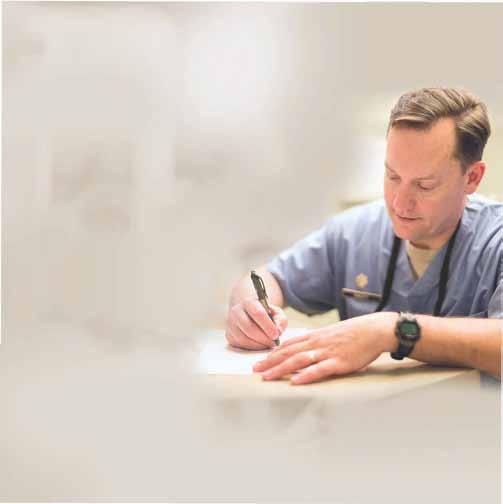

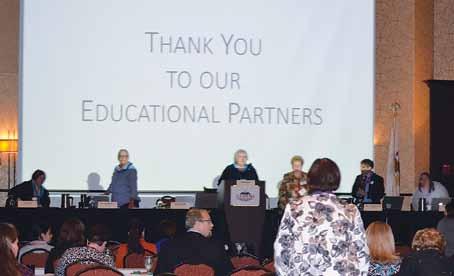



Amy Amarathithada, BSN, RN Loyola University
Introduction
Advancement of technology has changed the way people communicate. Paper charting or hand written communication has become extinct in healthcare. Healthcare professionals can easily document and access patient information through the electronic health record (EHR) system. Patients are encouraged through many healthcare organizations in utilizing their website to access their medical records. In addition, patients can now email their providers with any medical questions they have any time. With this new implementation, healthcare professionals need to be more cautious with patient information. As providers, it is our role to keep patient information private and confidential according to the Health Insurance Portability and Accountability Act of 1996 (HIPAA). Social media such as Facebook, Twitter, and Instagram has made it challenging for people to keep information private. People all over the world share their personal information through pictures and videos. Most people tend to forget that once something is shared over the internet, it is no longer private. The purpose of this paper is to present a case study analysis on breaching patient confidentiality. Next, the issue of breaching patient confidentiality through the use of EHR and social media will be discussed. In addition, the effects of EHR used in the healthcare profession and implementation of bioethics decision-making method will be presented.
Case Study
The use of digital communication such as EHR, email, social media, or the internet has become the norm in healthcare (Lo, 2013). However, the use of digital


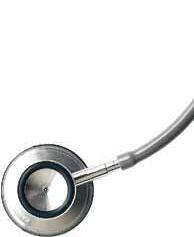



communication poses risks of breaching patient privacy and confidentiality. The following case study illustrates inappropriate use of digital communication: Trista was a new graduate nurse who landed her first job in the emergency department (ED). She was very excited to work in the ED and was eager to learn. On every shift, she would access and view patient information using the EHR system for her own learning experience even though some of the patients was not assigned to her. Her coworkers Nina and Darline noticed that she would access unassigned patient EHR on multiple occasions. Both co-workers ignored the issue each time they saw Trista inappropriately viewing patients’ medical records. During lunch, Trista would talk about some of the patients she looked up in the EHR system. One of the comments she said to Nina was, “I can’t believe how many drug seeking patients on record I found in the ED. Some of them I didn’t even take care of. They take pain meds like it is candy.”
Trista always carried her mobile device with her and would update her Facebook frequently about her workplace. At times, Trista would take photos in the ED. She posted pictures of herself at the nurse’s station and when she used the electrocardiogram machine for the first time. Trista was very friendly and wanted to become friends with her co-workers on her Facebook account. She became friends with Nina and Darline as well as other co-workers on the social networking website. Nina and Darline both noticed that Trista posted multiple comments and photos about their workplace and patients in the ED. However, neither has said anything to their manager.
One evening, Trista was assigned to a 17 year old female patient in the ED. The patient was diagnosed with a urinary tract infection and sexually transmitted disease. She took a picture of herself by the patient’s room and posted the picture on her Facebook page. Trista wrote the
following caption in the photo, “typical night, UTI and STDS.” The posted photo included the hospital name and room number. The background of the photo revealed the patient’s face partially shown through the hospital curtain. Her fellow co-worker Nina saw the photo Trista posted about her 17 year old patient on Facebook.
The use of EHR in healthcare is encouraged by the United States government. Digital technologies such as EHR present the promise of higher quality and more efficient healthcare (Lo, 2013). EHR are digital versions of paper charts that contain patient information documented by clinicians in provider offices, clinics, and hospitals. The use of EHR is very beneficial because it enables clinicians to track data over time, identify patients for screenings, monitor patient’s illnesses, and improve the quality of care provided (Ardito, 2014). In addition, the use of digital technology assists patients to become more involved in their own care. Patients can email medical questions to their providers, request for medication refills, book appointments, and access their own medical records with just a click of a button. However, the advancement of digital health information also brings burden and challenges for many healthcare organizations in protecting patient privacy. Healthcare professionals’ risk of breaching patient privacy and confidentiality has increased due to the implementation of EHR. All healthcare professionals should be aware and understand the law of HIPAA in order to avoid ethical privacy violations. HIPAA was mandated to protect patient’s rights for privacy of health information transmitted orally, on paper, or electronically (Lachman, 2013). Healthcare professionals should only
Case Analysis continued on page 6

Are you seeking to further your nursing education?
We invite you to learn about the many opportunities Lewis University offers to continue your education at the bachelor’s, master’s or doctoral level. At Lewis, you’ll experience a supportive learning environment that helps you to achieve your personal and professional goals, while balancing work and family life.
Contact Us grad@lewisu.edu (815) 836-5610 www.lewisu.edu/conhp
Healthcare Systems Leadership*
Education*
Adult Gerontology Clinical Nurse Specialist
Adult Gerontology Primary Care Nurse Practitioner (AGPCNP) • Family Nurse Practitioner (FNP) MSN/MBA DNP*
Case Analysis continued from page 5
access patient information through EHR when the clinician is caring for the patient. Inappropriate access of unassigned patient EHR for personal interests is considered breaching patient confidentiality.
The rise in the use of social media has also made its way in the healthcare industry. Healthcare organizations are encouraged to advertise about healthcare services through the use of social media such as Facebook and Instagram. According to Lachman (2013), social networking websites such as Facebook is the world’s largest professional network. Facebook currently has 750 million active users and 30 billion pieces of content is shared through its network monthly (Griffith & Tengnah, 2011). Like the general population, healthcare professionals post information on social media at similar rates. However, some materials posted by healthcare professionals can be problematic. According to Lo (2013), postings that contain sufficient detail to identify a patient breaches confidentiality. Once something is posted over the internet, it is no longer private and can become permanent. Healthcare professionals should expect that some patients will Google them and possibly forward information found via internet to others (Lo, 2013).
The United States encourage healthcare organizations to convert from paper charting to EHR. In February 2009, the federal government set aside 30 billion dollars to assist hospitals, clinics, and provider office-based in transitioning to electronic records (Ardito,



2011). Although the implementation of EHR will assist the healthcare profession in providing better care to the public, there are also disadvantages. The use of EHR and digital communication has made protecting patient privacy challenging despite congress passing the HIPPA act. The ethical issue of healthcare professional breaching patient confidentiality is on the rise and is impacting the healthcare profession in many ways.
Inappropriately accessing patient EHR or posting patient information through social media can harm a healthcare organization’s reputation (Lachman, 2013). Healthcare organizations such as hospitals or outpatient clinics face the consequences due to their healthcare professional’s poor judgement. Patients and their families will not want to go seek health services from an organization with a bad reputation. Like the general public, patients can see what healthcare professionals post on social media. Patients and their families can view any comments, photos, or videos that healthcare professionals post inappropriately. It is the role of healthcare professionals to safeguard patient’s right to privacy (Lachman, 2013). In addition, healthcare professionals such as nurses frequently fail to realize how quickly information is spread through the internet (Griffith & Tengnah, 2011).
The trusting relationship between patients and providers is affected by the issue of breaching patient confidentiality. The use of social media has impacted the way patients view their provider’s trust and medical judgement. Providers might use social media to express their feelings regarding a patient incident that occurred in the workplace. People can simply search the web and find postings on a provider’s personal blog. Healthcare professionals need to keep in mind that once something is posted, it may become permanent. Patients, their families, and potential patients who view inappropriate material regarding patient information may question the integrity, judgement, or trustworthiness of the provider (Lo, 2013).
Violating patient privacy has affected the healthcare profession in protecting the wellbeing and safety of patients. According to the Code of Ethics for Nurses, the patient’s well-being could be jeopardized and the patient-nurse relationship could be destroyed due to the unnecessary access to patient data or by the inappropriate disclosure of patient information (Lachman, 2013). In addition, the well-being and safety of patient should be the priority when receiving or conveying confidential information about the patient whether in oral, written, or electronic form (Lachman, 2013). Healthcare professionals can put patients at risk when posting information about patients on the internet or inappropriately accessing patient’s electronic records. Patients may not want their families to know that they were in the hospital. In addition, patients can be at risk with unwanted visitors who found out their information because a careless healthcare professional posted information with the hospital name and room number. Healthcare professionals can also put patients such as adolescents at risk for their well-being and safety. Adolescents tend to not seek care because they don’t want their parents to find out. If healthcare professionals breach patient privacy by posting comments in social media, adolescents will not seek care because they will be afraid their parents may find out about their care.
The presented case study shows an example of a healthcare professional breaching patient confidentiality on multiple occasions. It is necessary to utilize the bioethical decision-making method to help analyze and clarify the ethical issue arise in this case study. Bioethical decision-making model is a systematic approach to help distinguish situations where right and wrong are not defined clearly (Gilliland, 2010).













In the case study, Nurse Nina believes that violating patient privacy is a serious issue. However, is it Nina’s responsibility to report Trista or should Nina ignore the issue because there was no harm done on the patients? Gathering additional information will help Nina analyze the ethical components of the situation. The bioethical decisionmaking model will be utilized as a guideline for Nina and other healthcare professionals regarding an ethical situation.
The first step in the bioethics model is to the review the situation (Gilliland, 2010). Nina must determine the cause for the breaching of patient confidentiality. According to the case study, the cause is due to Trista taking advantage of utilizing the EHR system to access patient information and posting inappropriate material on social media. Nina may conclude that this ongoing behavior is a result of other fellow co-workers ignoring the issue of patient privacy violation.
The second step of the bioethics model is to gather additional information. Nina will need to ensure that she understands what Trista has discussed with her about patient information and what she saw on Trista’s Facebook. In addition, Nina must determine if she needs to gather additional information. Based on the case study, Nina can conclude that Trista provided many evidence that she is breaching patient privacy. Trista


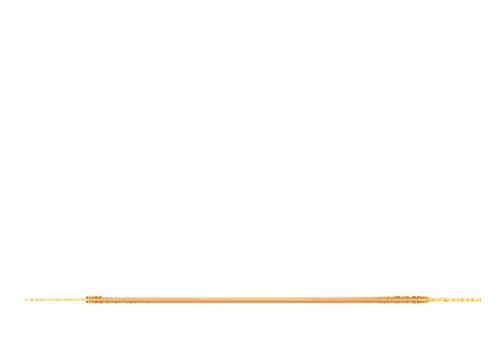
continuously access patient information on EHR and carelessly talks about patients during lunch. Trista also posted inappropriate material regarding her workplace and patient information on her social networking page.
The next step is to identify ethical issues in the situation (Gilliland, 2010). The ethical issue identified in this case study is breaching patient confidentiality on multiple occasions. Trista breached patient privacy due to the following:
• Inappropriately accessing patient electronic medical records on multiple occasions
• Made inappropriate comments about unassigned patients in the lunch room
• Using mobile device while working with patients
• Posting comments and photos regarding patients and workplace on social media
Step four of the bioethics model includes identification of personal and professional values (Gilliland, 2010).
Nina believes that breaching patient confidentiality is wrong. She believes that it is the role of the nurse to protect the patient’s right for privacy. At the same time, she understands that Trista is a new nurse who wanted to learn more about patients by accessing their records. Even though Trista did not cause harm to her patients, Nina believes that it is not right to violate a patient’s privacy.
In Step five, Nina must identify moral positions of key individuals involved (Gilliland, 2010). Nina recalls that Nurse Darline was present when Trista made inappropriate comments about patients in the lunch room. Darline is also friends with Trista on Facebook and saw her inappropriately posting a photo of a patient. Nina needs to clarify if Darline understands that Trista has violated patient privacy in many ways and on multiple occasions.
Nina concluded that Darline’s beliefs and values are the same as hers. Darline believes that Trista is wrong for breaching patient confidentiality. However, she did not report Trista because she believes Trista did not cause harm to any patients.
Identification of value conflicts is necessary in step six of the bioethics decision model. It is important to identify value conflicts because this can contribute to making ethical decision difficult (Gilliland, 2010). This case study shows that both Nina and Darline have value conflict. Both nurses agree that Trista has violated patient privacy. However, both chose to ignore the situation because they feel that Trista has not caused harm to any patients. Nina must decide what the best outcome is because Trista continues to violate patient privacy.
The next step in the bioethics model is to determine who should make the decision (Gilliland, 2010). Nina made the decision that she will be the one to report Trista to her manager. Darline has agreed with Nina that she will support her when the manager has questions about the situation of Trista violating patient privacy.
Step eight is to identify a range of actions with anticipated outcomes (Gilliland, 2010). The following are a list of possible actions and outcomes:
A. Report Trista to ED manager
• Action: Trista receives disciplinary action
ú receives re-education on patient privacy and confidentiality
ú not allowed to carry her mobile device during working hours
ú allowed limited access to the EHR system
• Outcome: patient’s privacy will no longer be violated
B. Continue to ignore the situation
• Action: Nina and Darline continue to ignore Trista’s ongoing behavior
• Outcome: Trista and potentially other healthcare professionals will continue to breach patient privacy
In step nine of the bioethics model, Nina must make the final choice for action. She needs to select the choice with the highest positive resolution (Gilliland, 2010). In this case, the best course of action is to select option A. Nina needs to report Trista to the ED manager. Trista has to be discipline for her actions and learn that she has violated patient privacy multiple times. Trista will learn from her mistakes and become more aware of her actions. In this case, the ethical duty is that nurses are accountable for their actions. It is a nurse’s duty to protect and respect the privacy of every patient.
In the last step, Nina must evaluate her decision and action (Gilliland, 2010). Nina made the right decision to no longer ignore the situation and report Trista. Trista violated her patient’s privacy when she posted a photo of the patient on Facebook. As a result, Trista no longer
takes photos or post comments about her workplace and patients. She only accesses patient information necessary to provide care to her assigned patients. In addition, patients at the ED can feel safe that their information will be kept private and confidential.
Conclusion
Healthcare professionals play a major role in advocating for patients as well as other fellow colleagues struggling with difficult ethical decisions (Park, 2009). In this case study, the ethical issue of breaching patient confidentiality that many healthcare professionals frequently face was identified. As a result of the case study analysis, other healthcare professionals can utilize the bioethics decisionmaking model to assist in solving future ethical dilemmas. Healthcare professionals such as nurses have the obligation to protect patient confidentiality and privacy. With the advancement of digital communication, it is apparent that nurses, providers, and other healthcare professionals must be cautious with keeping patient information confidential.
CE Offering
1.0 Contact Hours
This offering expires in 2 years: DECEMBER 14, 2017
The goal of this self-study is to review the digital communication processes used in healthcare and how it relates to patient privacy and confidentiality.
Learning Objectives:
1. Review a case study analysis on breaching patient confidentiality.
2. Review risks of breaching patient privacy and confidentiality when using digital communication methods.
3. Describe implementation of bioethics decisionmaking method and the effects of EHR used in the healthcare profession.
HOW TO EARN
CONTINUING EDUCATION CREDIT
This course is 1.0 Contact Hours
1. Read the Continuing Education Article
2. Go to https://ilnursesfoundation.wufoo.com/ forms/dec-2015self-study/ to complete the test and evaluation. This link is also available on the INF website www.illinoisnurses.foundation under programs
3. Submit payment online.
4. After the test is graded, the CE certificate will be emailed to you.
HARD COPY TEST MAY BE DOWNLOADED via the INF website www.illinoisnurses.foundation under programs.
DEADLINE
TEST AND EVALUATION MUST BE COMPLETED BY DECEMBER 14, 2017
Complete online payment of processing fee as follows: ANA-Illinois members- $7.50 Non members- $15.00
To earn 1.0 contact hours of continuing education, you must achieve a score of 80%
If you do not pass the test, you may take it again at no additional charge. Certificates indicating successful completion of this offering will be emailed to you.
The planners and faculty have declared no conflict of interest.
This continuing nursing education activity was approved by the Ohio Nurses Association (OBN-00191), an accredited approver by the American Nurses Credentialing Center’s Commission on Accreditation.
CE quiz, evaluation, and payment are available online at https://ilnursesfoundation.wufoo.com/ forms/dec-2015self-study/ or via the INF website www.illinoisnurses.foundation under programs.
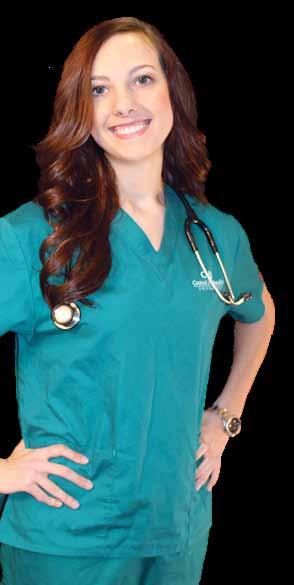
Mary Barton APN CNS CNP President ISAPN
Nurses... if we do not lead, they will lead us! I heard a nurse recently say…“they,” meaning the professional organization should have done something about…The details are not important. I have heard that many times throughout the years! When asked if he/she belongs, the answer – “no!”
What is HUGELY important for nurses, at all levels, all educational preparations to understand is that those organizations speak for “the nurses.”
If you are not a member, you have little say so in your profession because these organizations represent the members. The organizations have individuals who serve as our eyes, ears and our voices at many tables, including Springfield!
Nurses must understand that professional organizations are truly representing us at so many levels. As we move forward to the Sunset of our Nurse Practice Act in 2017 EVERY nurse in Illinois will want to “be in the know” about proposed changes and how that may impact your practice/your livelihood. If you are not a member how will you know what is happening? You are not happy with certain situations? It is time to speak up and make a difference!
A few facts – nursing organizations in general have lean budgets and cannot have large executive staffs, so a few strong people and perhaps a lobbyist or lobbyist team are the “employees.” The primary governing body is the BOARD of DIRECTORS. These are very dedicated nurses who, like you have jobs/families and numerous other commitments, yet they volunteer because they are just THAT committed. But, it is not enough to simply join the organization. It is important to be involved. That will mean something very different for each nurse. First, evaluate where you are in your clinical comfort level. If you have been in practice for three years or more (just a guess) you are probably feeling comfortable in your clinical skills.
Second, evaluate how much of your “free” time you have for your profession. I am sure that all of us can find some time towards our profession. We are ALL busy, but somehow find the time because it is THAT important. With that said, you may want to talk to your employer about the importance of being involved in your professional organization; perhaps some time could be carved out at work. That may be time you can use to work on a small project, visit a legislator, do some committee work, etc. Third, consider what your passion is and then join a committee. Even one or two hours a month is invaluable. Many hands do make light work! It really is fun to get to know your colleagues as you work toward a common goal. If you find that you are not able to volunteer your time, be an informed member. Make a commitment to read newsletters thoroughly, legislative reports critically, and regularly visit the website paying close attention to any updates. Additionally, you may be an ambassador to your colleagues about the importance of being a member of your professional organization.
Very little happens when one person stands to voice a concern, but if “in mass” that is done, the impact is far reaching! It takes many individuals working towards a common goal to have it realized!

When I say I’m a school nurse, the most common question/response I get is, “so how many students fake being sick?” My response is, “it’s so much more than that.” And I begin to tell them a few stories of a “typical day” in the life of a school nurse……...
School nurses arrive early many days, just to have a few moments of quiet to get organized and make sure the office is clean and ready. My day starts with morning medications, before the first class, that parents are unable to give at home for a variety of reasons. I’m greeted typically by a sports injury or two that needs attention. Parents stop by with their student – a sprained ankle, or concussion. The phone begins to ring, and emails flow in with parent and teacher/staff concerns or updates.
Then I’m off to a few meetings – a multidisciplinary team meeting, to discuss how we can support students struggling with a myriad of family/personal challenges, sometimes situations that should only be seen in a TV drama – financial struggles, an ill parent, divorce, abuse, neglect, mental illness, substance abuse, legal issues……... these are the kids we see often in the nurse’s office with psychosomatic complaints. School nurses play an important role in helping colleagues recognize the impact of a situation on a student’s health and ability to learn/be present in class. In the larger schools, we are fortunate to work with another nurse, usually part-time, but they provide vital support and nursing expertise to handle situations while the certified or professional educatorlicensed school nurse is attending multidisciplinary team or special-education meetings. Other meetings might include a district safety meeting, prevention/wellness team meeting, or teacher-parent meetings. School nurses play a vital role in the health of the school community.
As lunch time approaches, we prepare for medication administration – typically booster doses of ADHD medications – kids are in/out quickly so they get to class

on time. We might see a few physical education injuries along the way. We are called to the classroom/gym for a dislocated knee or shoulder, asthma attack, fainting in PE or health/science classes, an anxiety attack, a seizure in the classroom, or anaphylactic reaction. We are ready at all times, carrying radios, to listen for the emergency call. Not just students, but staff, too – bus driver in cardiac arrest, a custodian with a herniated disc, or a teacher in hypertensive crisis. I responded to a staff member who collapsed and two days later received a pacemaker. School nurses must be ready for anything, every day, constantly assessing the situation.
The afternoon brings more collaborative and detective work – the doctor’s note that only states, “no testing this week” to find out that the student had her first seizure over the weekend. Teaming with local clinicians to support a student with a concussion or diabetes…..Reassuring a student/cancer survivor that it’s just a sore throat and nothing more, helping a teacher understand what POTS diagnosis means…..Checking in with a parent of a concussed student who is struggling. The day usually ends an hour or two after students, and most staff have gone home – when it’s quiet, and we can finish our charting and paperwork, so we are ready for the next day’s challenges.
And I can’t forget to mention the unique cycle of a school calendar – the seasons, dances, sporting events, fine arts performances, holiday celebrations – the amazing energy in the building because we get to work with kids in community. School nursing is “so much more...” It’s a unique nursing specialty that combines pediatrics, emergency, psychiatric, community, and public health nursing. Each day presents new and unique challenges for an autonomous nurse who loves to work in a vibrant, everevolving, community of adults and children – empowering them to make healthy choices and be successful students. And I love it.
$20.00
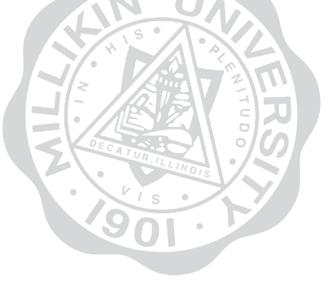
The Millikin University School of Nursing seeks faculty members to teach in its CCNE-accredited Baccalaureate and Master’s Programs, as well as, its Doctor of Nursing Practice Program (DNP). View a complete position description and minimum qualifications at millikin.edu/employment.
To apply, applicants should submit a letter of interest, curriculum vitae, brief teaching philosophy, evidence of teaching excellence, and 3-5 professional references to millikin.edu/employment. Review of applications will begin immediately and continue until the positions are filled. The start date can be as early as January 1, 2016 or Fall of 2016. Offer of employment is contingent upon successful completion of a background check. Millikin University is an equal opportunity employer. Women and minorities are encouraged to apply.

Make checks (in amount of $20.00) payable to Secretary of State Mail form and check to: Secretary of State Vehicle Services Department Special Plates Division 501 S. Second St., Rm. 312 Springfield, IL 62756
Rhys A. Gibson, BSN, RN, Chairperson
In April of this year, a team was assembled to successfully launch the inaugural 40 under 40 event celebrating emerging nurse leaders in Illinois. The committee was convened by the IL Healthcare Action Coalition, a leadership development project supported by a Robert Wood Johnson Foundation SIP grant. Team members included Dan Fraczkowski, MSN, RN, of MacNeal/Tenet, Shannon Halloway, PhD(c), RN, of RUMC and Franciscan St. Francis, Stephanie Mendoza, MSN, RN, of Norwegian American Hospital, Jennifer Grenier, MSN, RN-BC, of Rush Oak Park Hospital, and Rhys A. Gibson, BSN, RN, project chair, of MacNeal/ Tenet and UIC’s College of Nursing/Alumni Board. The 40-under-40 team hit the ground running and in a 6 month period of time created all aspects of the award from the application criteria and instructions to staging of the recognition ceremony on September 17 at Rush University. The distribution of the on-line application was supported by all Illinois professional nurse associations, which resulted in approximately 100 nominations. The team designed the award to recognize all levels of IL licensed nurses, LPNs, RNs and APNs under the age of 40 years. Nominations were received from patients, friends, family, coworkers, employers, students, etc. Award recognition recipients reflected leadership success, exemplary leadership qualities, participation in professional associations and community service.
Rush University Medical Center proved to be the perfect venue to host the event. Dr. Marquis Foreman echoed what many of us thought before in wondering…” how did we manage not to consider doing this before?” The accomplishments of each award recognition recipient can be readily viewed at the IL Nurses Foundation website http://www.illinoisnurses.foundation/photos-from-event/ Recipients were greatly pleased to be celebrated by members of their own cohort as well as Illinois nursing leaders.
The committee was truly moved to have the honor of acknowledging fellow nurses who are known change agents that help shape policy state wide and beyond.


Their efforts have served to expand and grow nursing practice as well as to empower our communities. We’re all looking forward to acknowledging the next cohort of nurse leaders in the years to come. Next year, this recognition event will be sponsored by the Illinois Nurses Foundation http://www.illinoisnurses.foundation/ Advisory committee consultants: Susana Gonzalez, MSN, RN, CNML, Director of Perinatal Services at
Vicki Keough, PhD Dean, Loyola University Chicago Marcella Niehoff School of Nursing
When Kelley Johnson stood up on the Miss America stage last month, she was a beautiful representation of the more than 3.1 million nursing professionals across the nation who are highly educated women and men dedicated to advancing health and providing high-quality care to their patients.
I understand the rigor and dedication it takes to become a nurse – and this is not a profession that should be mocked as it was following the pageant. It’s offensive to indicate that one of the tools nurses use to assess and diagnose health conditions is a “doctor’s stethoscope.”
We use stethoscopes, among other instruments, on a daily basis to obtain objective information about patient’s health conditions. And in today’s ever-changing health care landscape, nurses are not just meant to support doctors. It’s much more than that.
We provide hands-on health care, conduct groundbreaking research, shape health care policies, run large health systems and corporations, and provide service to those in need.
In fact, a growing number of education institutes are developing interprofessional programs, so all health care professionals can learn early in their careers to work as a team. In addition to nurses and doctors, public health, law, health systems management, business, bioethics, social work, nutrition, and exercise science students all become part of the learning environment. The goal is collaboration, breaking down silos, and navigating the complexities of the health care system together.
As Kelley mentioned in her monologue, she is “not just a nurse.” It’s important to know that in addition to caring for patients and working as a team with other health care professionals, nurses are now also conducting lifechanging research studies.
While research scholarship was once considered a field far apart from the practical study of nursing, today’s
nursing students are showing that it is central to the changing landscape of health care.
Researchers at the Loyola University Chicago Marcella Niehoff School of Nursing are discovering how Vitamin D supplements can help improve the mood and health of underserved women of color and improve symptoms and quality of life in women with metastatic breast cancer; they are studying health care outcomes of foster children, reviewing strategies for the next Ebola, and more.
Kelley brought attention to the fact that patients and families look to nurses to give them information, education, advice, support, and comfort when they are facing some of the most devastating times of their lives. This is a key part of a nurse’s role, but I would go a step further and say that our jobs are now beyond that. As our society looks to advance health care outcomes and eliminate health disparities, nurses will play a key role. We will not just support doctors, but come along side them as equal partners who will find solutions to some of the world’s toughest problems.






The American Nurses Association has declared 2015 to be the Year of Ethics and in January released a new edition of its Code of Ethics for Nurses with Interpretive Statements, so now is the perfect time for RNs to reexamine the essential role ethics plays in the nursing profession. Having a strong ethical foundation is a key component to a successful career. Yet, even the best nurses may find themselves struggling with ethical concerns on the job.
Here are five considerations for nurses when facing ethical challenges.
Know yourself
It’s important to have a strong sense of personal ethics to build upon in your profession. “Knowing who you are and what you stand for personally and professionally provides a foundation to speak up and speak out about issues that support or compromise your values,” said Cynda Hylton Rushton, PhD, RN, FAAN, Anne and George L. Bunting Professor of Clinical Ethics at the Berman Institute of Bioethics/School of Nursing and a professor of nursing and pediatrics at Johns Hopkins University, and a Maryland Nurses Association member. “Without this clarity, your responses may be reactive, unreflective and potentially damaging to you and to others.”
Live your values
Just knowing your values and ethics isn’t enough, Rushton said. “We are required to speak them and live

The American Nurses Association (ANA) is pleased to announce that ANA President Pamela F. Cipriano, PhD, RN, NEA-BC, FAAN, has been chosen as one of Modern Healthcare’s 100 Most Influential People in Healthcare. This program honors individuals in health care who are deemed by their peers and an expert panel to be the most influential individuals in the industry. Cipriano and ANA’s efforts to add more nurses to health care decision-making boards are also highlighted in the magazine.
The “100 Most Influential” honorees come from all sectors of the industry, including hospitals, health systems, physician organizations, insurance, government, vendors and suppliers, trade and professional organizations, and patients’ rights groups. Cipriano and the other honorees are currently highlighted in the Aug. 24 print edition of Modern Healthcare and online at http://www.modernhealthcare.com/community/100-mostinfluential/2015/.


them in our daily actions. This takes courage, wisdom and resilience. Living our values means that we have to take seriously the fifth provision of the ANA Code — our obligation to care for ourselves so that we can care for others.” Because ethical issues are part of daily nursing practice, every nurse has an obligation to have the knowledge, skills and abilities to recognize and address them.
Listen to your gut
If you know yourself and are consistent about living your values, you’ll be able to rely on that voice inside your head saying something is wrong. “One of the things I talk to my students about all the time is that you need to listen to your gut,” said Sarah Shannon, PhD, RN, associate professor of Biobehavioral Nursing and Health Systems at the University of Washington School of Nursing and adjunct associate professor of Bioethics and Humanities at the University of Washington School of Medicine, and a Washington State Nurses Association member.
Check in with others
Having said that, Shannon said it’s important to remember that the gut is “a great barometer but a lousy compass.” Just because you know you’re in an ethical quandary doesn’t mean you know what the next step is. Consult with others, such as your shift manager or head of nursing, when a sticky ethical situation arises.
Translating ethical decision-making into everyday nursing practice is challenging. Building a network
of colleagues who can help you think through ethical situations is a priceless resource. A great place to connect with experts and building your network is the 2015 ANA Ethics Symposium being held in Baltimore, MD, June 4-5.
Practice with respect
The first provision of the revised Code highlights each nurse’s responsibility to practice with “respect for the inherent dignity, worth, unique attributes and human rights of all individuals,” said Carol Taylor, PhD, RN, professor of nursing at Georgetown University and senior clinical scholar at the Kennedy Institute of Ethics, and an ANA member. Upholding that worth can provide a foundation for ethical action.
“Taken seriously, this means that each of us must practice with zero tolerance for disrespect, for our patients, their family members, our colleagues and ourselves,” Taylor said. Taylor recommended practicing responding to a colleague who describes a patient in negative terms to make it easier to speak up next time, such as by saying, “I’m no goody two-shoes, but I’m trying hard to meet each patient with respect.” If disrespect is a widespread problem, huddle and call attention to your organization’s zero-tolerance policy for disrespect to empower everyone to bring quick attention to violations.
For additional resources go to ANA’s Career Center at http://careers.ana.org
Reprinted with permission of The American Nurse
SILVER SPRING, MD – The nursing profession “will no longer tolerate violence of any kind from any source,” the American Nurses Association (ANA) declared in a new position statement on violence in health care workplaces released today.
“Taking this clear and strong position is critical to ensure the safety of patients, nurses and other health care workers,” said ANA President Pamela F. Cipriano, PhD, RN, NEA-BC, FAAN. “Enduring physical or verbal abuse must no longer be accepted as part of a nurse’s job.”
ANA’s position statement, developed by a panel of registered nurses (RNs) representing clinicians, executives and educators, addresses a continuum of harmful workplace actions and inactions ranging from incivility to bullying to physical violence. The statement defines bullying as “repeated, unwanted harmful actions intended to humiliate, offend and cause distress,” such as hostile remarks, verbal attacks, threats, intimidation and withholding support.
The statement calls on RNs and employers to share responsibility to create a culture of respect and to implement evidence-based strategies. The statement cites research showing that some form of incivility, bullying or violence affects every nursing specialty, occurs in virtually every practice and academic setting, and extends into all educational and organizational levels of the nursing profession.

RNs who belong to many of the more than 30 nursing specialty organizations affiliated with ANA provided input for the position statement.
A recent ANA survey of 3,765 RNs found nearly onequarter of respondents had been physically assaulted while at work by a patient or a patient’s family member, and up to half had been bullied in some manner, either by a peer (50 percent) or a person in a higher level of authority (42 percent).
Among the position statement’s recommendations to prevent and mitigate violence, in addition to setting a “zero tolerance” policy, are:
• Establishing a shared and sustained commitment by nurses and their employers to a safe and trustworthy environment that promotes respect and dignity;
• Encouraging employees to report incidents of violence, and never blaming employees for violence perpetrated by non-employees;
• Encouraging RNs to participate in educational programs, learn organizational policies and procedures, and use “situational awareness” to anticipate the potential for violence; and
• Developing a comprehensive violence prevention program aligned with federal health and safety guidelines, with RNs’ input.
To prevent bullying, among ANA’s recommendations are that RNs commit to “promoting healthy interpersonal relationships” and become “cognizant of their own interactions, including actions taken and not taken.”
Among recommendations for employers are to:
• Provide a mechanism for RNs to seek support when feeling threatened;
• Inform employees about available strategies for conflict resolution and respectful communication; and
• Offer education sessions on incivility and bullying, including prevention strategies.
ANA has several resources to help RNs and employers address and prevent bullying in the workplace, including the booklet, Bullying in the Workplace: Reversing a Culture, and a bullying “tip card.”
Illinois Homecare & Hospice Council (IHHC) is involved in an innovative project to share information about Palliative Care and to spread the word about how home-health services help prevent hospital readmissions. We are offering a Massive Open Online Course (MOOC) on these topics. Interested medical professionals can find out more and register at https://www.coursesites. com/webapps/Bb-sites-course-creation-BBLEARN/ courseHomepage.htmlx?course_id=_320761_1 to begin watching videos about pain management, care transitions, healthcare disparities, the business case for palliative care and much more. Follow the directions to “self enroll.” If you need more information visit IHA’s introduction to the MOOC at www.ihatoday.org/iha-institute/mooc.aspx
The MOOC, called “One Patient, One Team: Palliative Care Approaches Across the Continuum,” was developed in collaboration with the Illinois Hospital Association, Southern Illinois University School of Medicine and the University of Illinois Springfield. MOOC participants can earn six hours of CEs or MEs from SIU School of Medicine for just $60, or pay nothing and pick and choose what you want to see. Every eight weeks, the MOOC closes and reopens so those who are seeking continuing education credit can finish their work and receive credit. New students can then begin contributing fresh content to the message boards. The current session will close on Nov. 15. There will be only one more session after that, running from Nov. 16 through Jan. 15, so time is running out.
IHHC members are working on the legislative front to preserve Medicaid reimbursement rates for home health services, advocate for telehealth reimbursement and to allow nurse practitioners to order and certify home health services. The IHHC convenes an annual conference and exposition each Spring. Please check our website at www.ilhomecare.org for information about the March conference.
The Illinois Homecare & Hospice Council (IHHC) is the nation’s first home-care association and was established in 1960. It represents over 240 home health, hospice, and allied organizations in the state. The 20152018 strategic plan includes four key areas: Expand Knowledge, Lead Change, Build Support, and Create Value. IHHC is governed by an elected 10 member board of directors and utilizes a committee structure to drive outcomes. Committees include Legislative, Finance, Education, Best Practices, Hospice, Private Duty, Regulatory & Reimbursement, and Member Services. IHHC developed a Code of Ethics in 2008 to declare the commitment to ethical practice in the industry.

Four Saint Xavier University (SXU) students from the School of Nursing (SON) have been awarded scholarships of $2,500 each from the Blue Island Community Healthcare Foundation for the 2015-2016 school year. The students are Katherine Clark, Brian Conrad, Roxana Flores Oliva, and Melissa Jeka.
Katherine Clark is a senior nursing student from Oak Lawn. She has served on the Nominations and Elections Committee for the Student Nurses Association of Illinois and was vice president of SXU’s Student Nurses Association this past year. She currently works at Advocate Children’s Hospital as a patient care tech on the Pediatric Surgical Heart Unit. She hopes to continue working for Advocate after completing her RN.
Brian Conrad of Mount Greenwood is a Junior II nursing student. He’s currently working as a collegiate nurse at Mercy Hospital, but his long-term nursing goals include fostering health literacy within the community, in particular, approaches to tackling obesity through positive nutritional choices.
Roxana Flores Oliva is from Blue Island. She is a Junior I nursing student with a minor in Spanish. Upon becoming a nurse, she plans to use her Spanish fluency to encourage and provide health care in communities where language
may be an obstacle, “because,” she states, “there should not be any barriers preventing a patient from receiving the care they deserve.”
Melissa Jeka is a senior nursing major from Evergreen Park. In addition to being a full-time student, Melissa works at a busy restaurant, is a single parent, and participates in SXU’s Student Success Program. She hopes to become a labor and delivery nurse, in part because she experienced firsthand how valuable great patient care is when she gave birth to her son.
These experiences, along with a quality SXU education, are sure to make all four of these scholarship recipients excellent nurses in the future. The students and SXU are grateful to Blue Island Community Healthcare Foundation for its generous gift.
Founded in the 1970s as a supporting organization for St. Francis Hospital, Blue Island Community Healthcare Foundation continues the legacy started by St. Francis Hospital, which operated as a nonprofit in Blue Island, IL for over a century. The organization now funds various charitable groups that serve the area in providing such services as health screenings, programs for disabled children and adults, assistance for those with mental illness and addiction, and nursing education.

Melinda Noonan, DNP, RN, NEA-BC, FACHE President of Illinois Organization of Nurse Leaders
One of the greatest challenges for contemporary nurse leaders is engaging the hearts and minds of the nursing workforce. How does a nurse leader respond to the ubiquitous staff nurse messages about working short-staffed, overtired, and emotionally and physically stressed? The answer to this question was the focus of the Illinois Organization of Nurse Leaders (IONL) Annual Meeting and Conference in Lisle, Illinois at the end of September. It appears that the programming was on target as over 300 Illinois nurse leaders attended. The largest conference attendance in the history of the organization!
The IONL Program Committee planned an outstanding program that included national and regional speakers on topics as diverse as leading the multigenerational workforce, protecting nurses and hospitals from external threats (legislation), delivering lifesaving leadership internationally during the Ebola outbreak, caregiver self-care strategies, emotional intelligence, employee engagement, caring across the care continuum, and reducing moral distress.
Nurse leaders in attendance reflected the membership of IONL – evenly distributed between chief nursing officers/vice presidents, directors/associate vice presidents/associate chief nursing officers, and managers/ supervisors. Nurse leaders at every level expressed the timeliness of the topics to assist with their current leadership challenges.
Although most of the nurse leaders in attendance were from the Chicagoland regions (2A, 2B, 2C), it was noteworthy that the relevance of the programming attracted a significant number of attendees (33%) from outside of those regions.
Consistent with the IONL mission – “The organization for the advancement of leadership among Illinois nurses” – the organization continues to provide germane educational programming for nurse leaders at any level in an organization in any work setting across the state. The educational benefits afforded members are crucial for the forty-seven percent of IONL members certified in specialties.
Leadership development opportunities have become a unifying theme for all members. Traditionally, IONL members have worked in hospital and health network settings. With the inception of the Continuum of Care Committee in 2013, IONL membership is gradually changing to more diverse work settings. Please visit www.ionl.org for membership information and the schedule for upcoming events.
Southwest Region Indian Health Service
The Southwest Region Indian Health Service is seeking Registered Nurses in multiple specialties including Medical/Surgical, ER, OB/L&D and Leadership Roles. Bring your innovative spirit to improve the health status of our Native American population.
Why Nurses Choose IHS:
• Loan Repayment Program –Up to $20,000 annually
• Competitive Salaries
• 10% evening/night differential
• 25% weekend differential
• 26 vacation days
• 13 sick days, 10 Federal holidays
• Numerous health plans to choose; continue in retirement
• Transfer opportunities–1 license/50 states
• Outstanding Federal Retirement Plan, and much more
Our nursing career opportunities are available in rural and urban locations throughout the states of Arizona, Nevada and Utah
The Southwest Region also has the largest Medical Center in the Indian Health Service located in downtown Phoenix

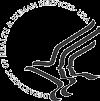
The Illinois Healthcare Action Coalition Practice Workgroup was charged with completing an asset map for Advanced Practice Nurses (APN) in Illinois. A specific aim was to host forums where data related to diversity in the APN workforce was disseminated. Two forums were hosted to disseminate the APN workforce data and to generate discussion on current issues in diversity.

The forums consisted of presentations of APN and RN workforce data on diversity, and panel discussions were focused on current and future strategies to address diversity in the APN workforce. The forums were supported by a Robert Wood Johnson SIP grant. The IL Nurses Foundation is the fiscal agent for the grant. Shannon Halloway, Jonas scholar and PhD candidate at Rush University College of Nursing and S. Swart, PI of RWJF SIP grant, ED ANA-Illinois and ISAPN coordinated both forums.
The panel discussion and audience participation centered on the need for recruitment of diverse students to enter Registered Nurse and Advanced Practice Nurse Programs, and thus the workforce.
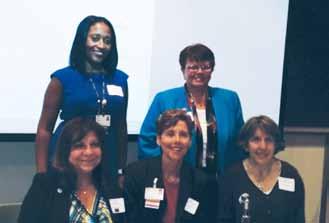

The first forum took place at Lewis & Clark Community College in Edwardsville. Panel members included: 1) Charlene S. Aaron PhD, RN, Assistant Professor, Mennonite College of Nursing; 2) Amelia Pérez, PhD, RN, Assistant Professor, School of Nursing, Coordinator of the Simulation Learning Center for Health Sciences; 3) Lisa Klaustermeier, MSN, RN, Chief Nursing Office, Anderson Hospital; and 4) Kathleen Delaney, PhD, PMH-NP. PMH-NP, Professor and Program Director of the PMH-NP program, Project Director of the RUMC Graduate Nursing Education Demonstration.
The second forum was at the Rush University College of Nursing in Chicago. Panel members were: 1) Beth Marks, PhD, RN, Associate Director for Research, Rehabilitation Research and Training Center on Developmental Disabilities (DD) and Health, University of Chicago Illinois; Research Associate Professor, Department of Disability and Human Development, UIC; and, codirector, National Organization of Nurses with Disabilities; 2) Lisa Rosenberg, PhD, Associate Professor and Associate Dean of Students, Rush University College of Nursing; 3) Monique Reed, PhD, RN, Associate Professor, Rush University College of Nursing; 4) Kathleen Sparbel, PhD, FNP-BC, Clinical Assistant Professor, Family Nurse Practitioner Program Director, Director of the Quad Cities Regional Campus; and 5) Susana Gonzalez MHA, MSN, RN, CNML, Director of Women Services, MacNeal Hospital.
Following the panel presentations, there were lively discussions on diversity issues concerning disability and successes and challenges of current diversity recruitment and retention programs.
Hannon, MSN, RN, on Being Selected as a Robert Wood Johnson Foundation Public Health Nurse Leader



Nurses interested in a rewarding career, please contact Kevin Long at 602-364-5178, or email Kevin at Kevin.long@ihs.gov


The Illinois Healthcare Action Coalition congratulates Robin Hannon, MSN, RN, Director Personal Health, St. Clair County Health Department, Belleville, Illinois on being one of 25 nurses from across the country selected as a Public Health Nurse Leader by the Robert Wood Johnson Foundation. She will participate in a two-year leadership development program designed to strengthen the capacity of senior public health nurses to improve health and lead collaboration in their communities.
As a part of this program, Hannon will work closely with the Illinois Healthcare Action Coalition to implement recommendations from the Institute of Medicine’s Future of Nursing report, as part of the Future of Nursing: Campaign for Action

I hope we’ll talk soon. Your Southwest adventure awaits you.
Hannon is a Director of Personal Health at the ST. Clair county Health Department, which is located in the metro-east area of St. Louis, Mo. Hannon is working in a leadership capacity with a coalition that is in the process of forming a consumer coalition that will give women a direct voice in the Maternal Child Health plan for the Illinois Department of Public Health.
“We congratulate Robin on her award,” said Dr. Maureen Shekleton, IL Center for Nursing Chairperson
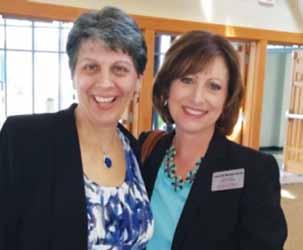
Robin Hannon, MSN, RN and Southern Illinois University at Edwardsville Dean Dr. Laura Bernaix at the IHAC Diversity forum, Edwardsville, IL on August 27, 2015.
and co-lead of the Illinois Healthcare Action Coalition. “We are so excited to work with her and for the public health expertise they are bringing to our Action Coalition. This collaboration will help us to further our work building healthier communities here in Illinois.”
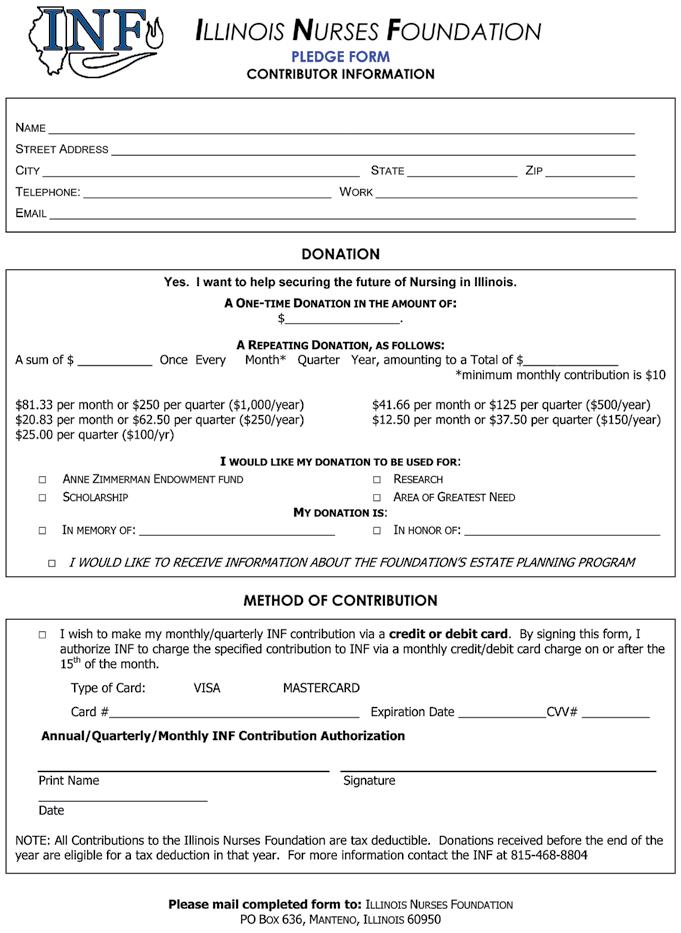
Sept. 15th 2015
Chicago, Illinois
This year Susana Gonzalez was recognized as the nurse of the year. Susana works at Macneal Hospital as the Director of perinatal services. In addition; Susana is president, of Illinois Hispanic Nurses Association. Susana models true servant leadership in her life. Her passion for inspiring nurses is part of her commitment to make the world a better place.
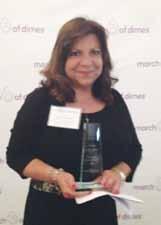
The March of Dimes Jonas Salk Award identifies individuals who demonstrate the mission of the March of Dimes; to improve the health of babies by preventing birth defects, prematurity, and infant mortality. Susana was honored for the loyal and active role she plays on issues related to women, youth, children, and the nursing profession.




Alpha Eta Chapter of Chi Eta Phi Sorority, Inc. Beta Mu Chapter of Lambda Pi Alpha Sorority Provident Hospital Nurse’s Alumni Association
P.O. Box 490204
Chicago, IL 60649-0204
You are invited to the 28th National Black Nurses Day Annual Ceremony Friday, February 26, 2016
“As nurses, we have a unique opportunity to heal the heart, mind, body and soul of each patient, their families and ourselves.” As Maya Angelou so eloquently stated, they may forget your name, but they will never forget the way you made them feel.
Please join us for the 2016 National Black Nurses Day Ceremony on Friday, February 26th, 6:00pm, at the Apostolic Faith Church, 2823 S. Indiana Avenue, Chicago, IL. The 2016 theme is: “Black Healthcare Providers Matter: Honoring matriculating BSNs, MSNs, DNPs and PhDs.” Family, friends, and all nurses and student nurses are welcome to attend. Keynote speaker TBD.
This annual event is sponsored by: Chicago Chapter National Black Nurses Association, Alpha Eta Chapter of Chi Eta Phi Sorority, Inc., Beta Mu Chapter of Lambda Pi Alpha Sorority, and Provident Hospital Nurses Alumni Association. For more information, please contact the Chicago Chapter National Black Nurses Association, P.O. Box #49024, Chicago, IL 60649-0204; email: nbndc26@ gmail.com or call 773-792-7222.
The National Black Nurses Day was proclaimed February 3, 1989 to applaud the contributions made by black health care professional practitioners. The month of February is slated for this annual event as a means to honor the contributions made by black Americans in the United States. Thus, since it is black history month it is a perfectly, noteworthy time to give homage to black nurses for their leadership and significant contributions made within the community and in our country.

Etsy: http://www.etsy.com/shop/ simplewreath
E-mail: simplewreath@gmail.com
Custom orders & monograms available! Please enjoy 10% off with coupon code: NURSE10


For Immediate Release
October 20, 2015
Contact: Terry Horstman
Phone: 217-558-2953
E-mail: Terry.Horstman@Illinois.gov
CHICAGO — Last week, the Illinois Center for Nursing convened a meeting of Illinois nurses associations to provide an opportunity to introduce Illinois Department of Financial and Professional Regulation (IDFPR) Secretary Bryan Schneider and Professional Regulation Director Jay Stewart to the strength and diversity of Illinois’ nursing professionals. Approximately 20 nurses associations were in attendance at the James R. Thompson Center for the first-ever assembly to give a brief overview of their association, providing insights into practice regulation and department priorities.
“The services provided by our nursing community are critical to the well being of Illinois’ citizens,” said Bryan Schneider, IDFPR Secretary. “Gathering our nursing stakeholders like this is a great way to learn more about
the issues impacting nursing so that, as regulators, we foster their ability to practice.”
Secretary Schneider noted that in efforts to provide a more efficient and responsive regulatory experience, IDFPR is implementing a new electronic license renewal notification process. According to Schneider, the move away from the paper-based license renewal notification will save valuable state resources, while providing better service to our licensed professionals.
In an effort to make this transition as smooth as possible, IDFPR is updating its website to collect email addresses and phone numbers of licensees. This information will be used to send Department notifications in the future. In the meantime, the Department is working to enhance its licensee database by collecting email addresses and phone numbers for licensees that have not submitted this information in the past.
A special thanks to the Illinois Nurses Foundation for graciously providing snacks.
Nurses Associations in attendance included: American Assoc Men in Nursing, Great Lakes Chapter ANA-Illinois
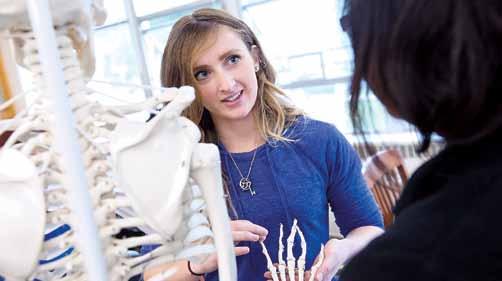
Chicago Bilingual Nurses Consortium
Chicago Chapter National Black Nurses Association
Development Disabilities Nurses Association of IL
Emergency Nurses Association-Illinois Council
Illinois Association of Colleges of Nursing
Illinois Association of Nurse Anesthetists
Illinois Association of School Nurses
Illinois Board of Nursing
Illinois Community College Deans & Directors
Illinois Hispanic Nurses Association
Illinois League for Nursing
Illinois Nurses Foundation
Illinois Organization for Associate Degree Nursing
Illinois Organization of Nurse Leaders
Illinois Public Health Nurse Administrators
Illinois Society for Advanced Practice Nursing
International Polish Nurses Association
National Organization of Nurses with Disabilities Philippine Nurses Association of Illinois
Other Groups in attendance:
Leading Age Illinois Illinois Homecare and Hospice Council


Bruce Rauner, Governor Bryan A. Schneider, Secretary Jay Stewart, Director, Division of Professional Regulation
The Illinois Board of Higher Education (IBHE) and the IDFPR Advisory Board for the Illinois Center for Nursing (ICN) recognized the 2015 Nurse Educator Fellows on September 9, 2015 in a joint ceremony held in Chicago and Springfield. This distinguished group of 22 Nurse Educator Fellows were nominated by their schools and selected from 49 nominations. The Fellows shared information about their research projects with the group of nursing leaders and were commended for their work
and dedication to preparing highly qualified nurses for the Illinois workforce.
Unable to attend: Tamara Bland, MSN, RN, Resurrection University; Denise Caldwell, MSN, RN, Lewis & Clark Community College; Tisha Goad, MSN, RN, Lake Land College; Jennifer L. Grobe, MSN, CCM, RN, Rockford University; Anne Hustad, MSN, RN, Olney Central College - Illinois Eastern Community Colleges; Pam Laskowski, MSN, RN, CNE, Millikin University; Donna Martin, MSN, RN-BC, CMSRN, CDE, Lewis University; Tina Parks, MS, RN, Prairie State College; Megan Pet, MSN, MBA, RN, Moraine Valley Community College; and Monique Reed, PhD, RN, Rush University.
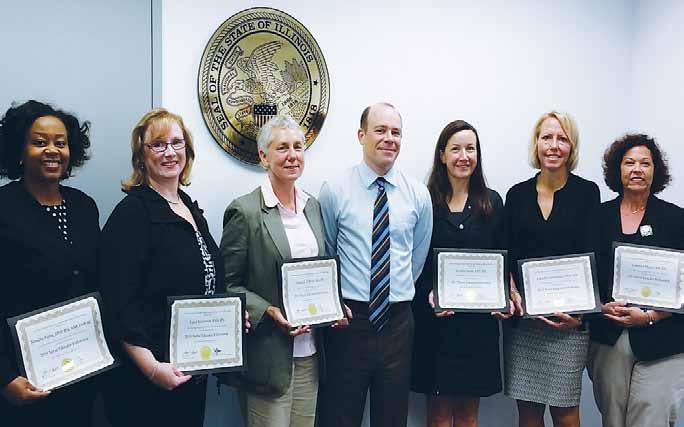
Catherine Maney, MS, RN, Northern Illinois University.

to R: Amanda Hopkins, Ph.D., RN, Illinois Wesleyan University; O. Ed Reitz, Ph.D., RN, Illinois State University; Amy Grugan, MSN, RN, Bradley University; Angela J. Caldieraro-Bentley, MS, RN-BC, St. John’s College; Richard Ellis, MSN, MSHA, RN, Methodist College; and Kevin Schoeben, IBHE Deputy Director for Fiscal Affairs.

How much will it cost to renew my IL RN license?
The fee for renewal of a professional nurse license shall be calculated at the rate of $40 per year or $80/2 years prior to 5/31/2016 (IL NPA Rules Section 1300.30 Fees b) Renewal Fees).
What is the quickest way to renew my IL RN license?
The quickest way to renew your IL RN license is via the internet; you can pay quickly and easily with a credit card. There will be an additional fee when you use a credit card via the internet to renew your IL RN license in 2016. You may not renew with a credit card if you are renewing after the expiration date, changing your name or requesting a waiver of CE requirements. Licenses renewed by credit card are processed and mailed within one week
How will I know when the IDFPR website is available to renew my IL RN license?
All 180,000 IL RNs are mailed a colored postcard in March. This post-card includes a PIN/personal identification number which you will need to use to complete the on-line credit card renewal process. If you misplace or do not receive this IL Department of Financial & Professional Regulation/IDFPR license renewal postcard, please go to the IDFPR website http://www.idfpr. com/ click on the “license renewal” icon in the center of the page, and follow the directions.
What if I want to place my IL RN license on inactive status?
During the renewal cycle please go to the IDFPR website http://www.idfpr.com/, click on the left side of the page tab “license renewals,” and follow the directions for print renewal. No fee is required to place your license on inactive status prior to 5/31/16 – but you must complete and sign this renewal form and return to IDFPR Licensing in Springfield, IL prior to 5/31/16.
How can I change my address?
To change your address online, please go to the IDFPR website, https://www.idfpr.com/applications/ LicenseReprint/. At the top of the page, click on the blue letters “License Reprint/Address Change.”
Note: change of name CANNOT be made via an online process. If your name has changed, you must submit a written notice to IDFPR and include documentation of the name change (marriage license, court order, or divorce decree). There may be a fee for this service. Information regarding the name change process is on the same page as the License Reprint/Address Change.
Must I renew my IL RN license prior to renewing my IL APN license?
Yes, you must first complete renewal of your IL RN license prior to renewing your IL APN license.
Is there someone that I can talk to?
Yes, please call the IDFPR call center:1-800-560-6420, Monday through Friday.





